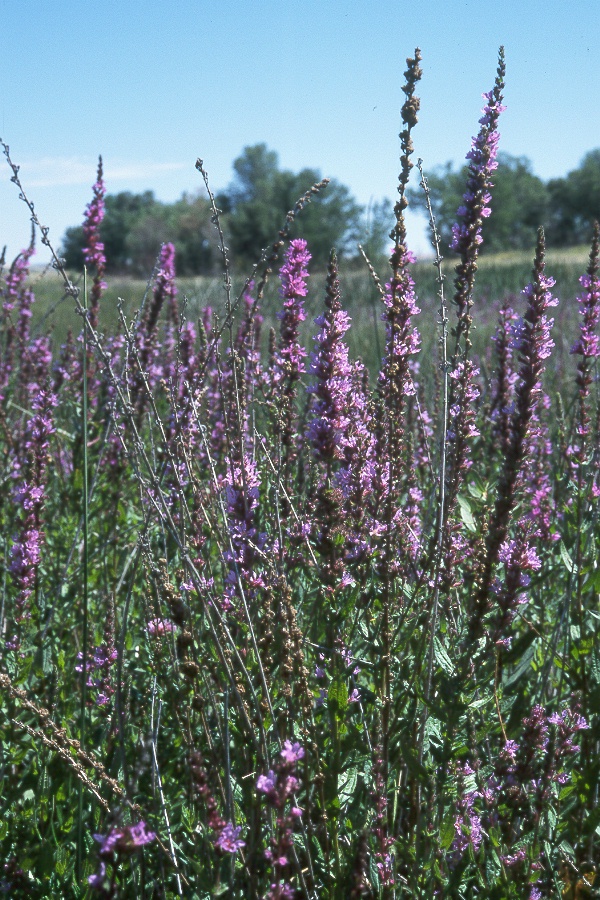-
Lythrum
salicaria
(purple loosestrife)
Weed ID Links Photo's
 Photo
by: Bob Richard, USDA-APHIS-PPQ. Location: Yellowstone
Co., MT.
Photo
by: Bob Richard, USDA-APHIS-PPQ. Location: Yellowstone
Co., MT.
Roots: The roots are an abbreviated (short) and robust (thick) woody taproot. If they break, new shoots can sprout from the roots. (2)
Stems/Leaves: The multiple-branched stems are erect and square. They are semi-woody and can grow 1.5 to 8 feet tall. The leaves are lanceshaped and entire (whole). They have smooth margins (edges) and are arranged in whorls (3 or more leaves originating from the same point in the stem) or opposite patterns (every other leaf connects to the opposite side of the stem than the leaf before it). (2)
Flowers: The magenta colored flowers have five or six petals and are arranged in a long spike-shaped inflorescence (cluster of flowers attached to the stem). (2) The flowers bloom from July until September. (4)
Seeds: The seeds are oval shaped and 1 mm long. They develop in capsules that burst when the seeds are mature. One mature purple loosestrife plant can produce over two million seeds per year. (2)
Methods of Reproduction: Seeds are the primary method of reproduction. Sprouts shooting from cut stems and roots are a secondary method. (2)
Life Styles/Habits/Life Duration: Purple loosestrife is a herbaceous (non-woody) perennial (lives three or more years). (2) It grows up to ten feet tall and produce 50 stems on one plant. It lives in wetlands and spreads rapidly.
Montana Infestation/History: Purple loosestrife is an extremely new plant to invade Montana. (It has only begun to infest this state in the ‘90's.) (1)
Environments Favorable to Infestation: Purple loosestrife is found almost entirely in Riparian (wet) areas. Wetlands such as river and stream banks, wet meadows and fields, flood plains, ponds, lakes and marshes are favorable growing areas. Moist disturbed areas (areas disrupted by human or natural causes) like roadsides and construction areas are also favorable. (4)
Impacts: Purple loosestrife can spread rapidly through a marshland and is much hardier than other native plants; therefore, it kills off other species of plants in the wetland. Eventually the wetland will become a monoculture (1 kind of plant) of purple loosestrife. Waterfowl and other wild animals that are dependent on the native plants will also have to leave the wetlands if purple loosestrife takes over. It can also impede the flow of irrigation ditches and other small waterways. (4)
Comments: This plant has just begun to invade Montana. It is crucial to take all measures to control the spread of purple loosestrife. Also, although they are very attractive plants, do not plant them in gardens. Many garden catalogs sell purple loosestrife, but it is a noxious weed and will harm the ecosystem of Montana's wetlands. (1)
Native Range/Probable Entry into North America: Purple loosestrife's native range is in Europe, North Africa, and Asia. It may have entered North America in the early 1800's. Purple loosestrife seeds reached North America in soil used as a ballast in European ships. Also, seeds may have reached North America on raw wool or sheep imported from Europe. (2)
Chemical Control: Chemical control is very expensive and ineffective for long-term relief. Herbicides that kill purple loosestrife also kill other broad-leafed plants and some narrow-leafed plants; therefore, this is not usually a viable option in wetlands. (3)
Cultural Control: I found no data pertaining to the cultural control of purple loosestrife.
Hand Pulling or Mowing/cutting: Hand-pulling requires that the entire plant and roots be removed (if the roots break, new shoots can sprout and regrow). This method is generally only used for immature purple loosestrife plants. Cutting the flower spikes before or at the beginning of the blooming season reduces seed production. Mowing must be repeated several times because it doesn't remove the roots. All of these methods are painstaking and ineffective. (3)
Biological Control: Biological control is a good long-term method to control and reduce purple loosestrife infestations. This type of control reduces the density of the infestation, not completely eliminating it. It makes purple loosestrife part of the multicultural (many different species of plants) wetland. The Department of Agriculture has approved some species of insects for bio control. The leaf-eating Galerucella beetles (like the Galerucella pusilla) and flower-eating weevil, Nanophyes marmoratus, are some of the host-specific (only feed on purple loosestrife) used for biological control agents. The Galerucella beetles decrease shoot length and suppress flower and seed production by feeding on the leaves, stems, and buds. (3)
How to Prevent Spread: After driving through wetlands,
wash off
the undercarriage and wheels of your car. While in the
wetlands, make sure
no purple loosestrife gets stuck in your car when shutting
doors. Also,
do not move lily pads (which could have seeds stuck to the
bottom) from
one pond to another. Keep your hip boots, waders,
fishing equipment,
boat and boat trailers free of seeds and plant parts. (1)
Bibliography
1) Breitenfeldt, Todd, Personal Interview, Biology Teacher, Whitehall Schools, Box 1109 Whitehall, MT 59759. (406)-287-3862. 9/1/1999.
2) Reese, Norman, et. al., Ed., Biological Control of Weeds in the West, Western Society of Weed Science, in cooperation with USDA ARS, MT Dept. of Agriculture, and MT State Univ., Color World Printer, February 1996.
3) Ellis, Donna. Control of Purple Loosestrife. [Online] Available http://www.canr.ucon.edu/ces/ipm/general/biocntrl/lspstr3m.htm, September 1999.
4) Ellis, Donna. Purple Loosestrife: Beauty or Beast?.
[Online] Available
http://www.canr.uconn.edu/ces/ipm/general/biocntrl/lsetrife.htm,
September 1999.
By: Shane Clark Published by: Joe Perigo 11/17/99.
Back mtwow.org HOME